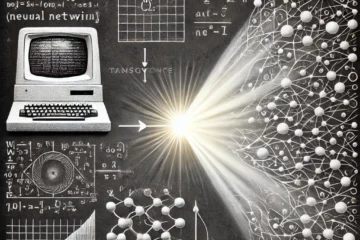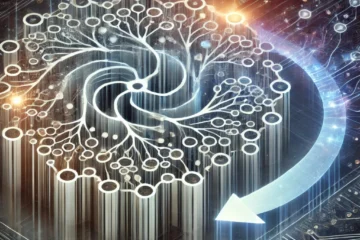
A conceptual illustration of a Recurrent Neural Network (RNN
Briefing on Recurrent Neural Networks (RNNs)
Introduction
Recurrent Neural Networks (RNNs) are a class of artificial neural networks designed to recognize patterns in sequences of data. Unlike traditional feedforward neural networks, RNNs have loops that allow information to be passed from one step of the sequence to the next, enabling them to maintain a form of memory over time. This makes RNNs particularly effective for tasks where the order of input data is important, such as time series forecasting, natural language processing, and speech recognition.
Basic Structure and Functionality
RNNs are structured to handle sequential data by maintaining a hidden state that is updated at each time step in the sequence. The key feature of RNNs is their “recurrent” connections, where the output of the current step is fed back as input to the network in the subsequent step.
- Input Layer: Each input in the sequence is presented one at a time, with each input representing a single time step.
- Hidden Layer: The hidden state in the RNN maintains information about the previous time steps, which helps the model make predictions based on previous data.
- Output Layer: After processing each input, the network produces an output that can be used for classification, regression, or other tasks.
In the simplest form, at each step t, the hidden state h_t is updated using the formula:
Where:
is the hidden state at time step
,
and
are weights connecting the previous hidden state and current input to the hidden layer,
is the input at time step
,
is an activation function (e.g., tanh or ReLU).
The RNN “remembers” information from previous inputs by maintaining this hidden state.
Challenges of Traditional RNNs
While traditional RNNs are powerful for modelling sequences, they suffer from significant limitations, notably:
- Vanishing Gradient Problem: During training, gradients can become very small (vanish), making it difficult for the network to learn long-range dependencies in the data.
- Exploding Gradient Problem: In some cases, gradients can grow excessively large, leading to unstable training.
Both of these issues arise due to the repeated multiplication of small (or large) gradients through the recurrent connections across many time steps.
Advanced Variants
To address the limitations of standard RNNs, several advanced variants have been developed, with two key models standing out:
-
Long Short-Term Memory (LSTM): LSTMs introduce a gating mechanism that regulates the flow of information in the network, allowing the model to retain information over longer sequences. They include “forget” gates that control how much of the past memory should be kept and “input” gates that decide how much new information should be added to the memory.
-
Gated Recurrent Unit (GRU): GRUs are a simplified version of LSTMs, combining the forget and input gates into a single “update” gate. GRUs tend to perform similarly to LSTMs but are computationally more efficient due to their simpler architecture.
Both LSTM and GRU architectures are designed to mitigate the vanishing gradient problem, making them more effective for learning long-range dependencies.
Applications of RNNs
RNNs and their advanced variants (LSTM and GRU) have been applied to a wide range of applications, particularly those involving sequential data:
- Natural Language Processing (NLP): RNNs are used for tasks like language modelling, machine translation, and sentiment analysis, where understanding the sequence of words is critical.
- Speech Recognition: By modelling the sequence of sound waves, RNNs are commonly employed in automatic speech recognition systems.
- Time Series Prediction: RNNs can be used to forecast stock prices, weather patterns, or any other form of time-dependent data.
- Music Generation: By training on a sequence of musical notes, RNNs can generate new compositions that follow a similar structure to the input data.
Limitations and Challenges
Despite their strengths, RNNs still face challenges:
- Training Complexity: RNNs, especially LSTMs and GRUs, require significant computational resources, especially when dealing with very long sequences.
- Difficulty with Extremely Long Sequences: While LSTMs and GRUs are better at handling long-range dependencies than vanilla RNNs, they still struggle with very long sequences.
- Parallelization: RNNs process data sequentially, making it difficult to parallelize training effectively, leading to longer training times compared to other models like convolutional neural networks (CNNs).
Alternatives and Complementary Models
Several models have emerged as alternatives or complements to RNNs for sequential data:
- Transformers: Transformers, which rely on self-attention mechanisms, have gained popularity due to their ability to handle long-range dependencies more efficiently and parallelize training. Models like BERT and GPT are based on transformer architectures.
- Convolutional Neural Networks (CNNs): While typically used for image processing, CNNs can also be applied to sequential data in certain cases (e.g., for text classification tasks).
Conclusion
Recurrent Neural Networks are a powerful tool for sequence modelling, enabling applications in areas such as NLP, speech recognition, and time series forecasting. However, their traditional forms have limitations that have been addressed with variants like LSTMs and GRUs. As AI continues to evolve, the exploration of alternative architectures such as transformers offers exciting new possibilities for sequence processing. Understanding these models’ strengths and weaknesses will be crucial in the ongoing development of AI systems.




0 Comments